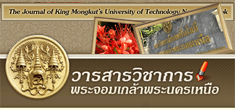Abstract
This is an applied research to analyze greenhouse gases of a batik shirt’s life cycle from Somboon Textile Factory in Chiang Mai. The functional unit of the system was set to be a rosette batik shirt with the chest size of 42 inches which was made from cotton weave. The greenhouse gases assessment started from raw material, production, transportation, distribution, usage until final disposal. The results showed that the greenhouse gases released from batik shirt’s life cycle was 3.59 kg CO2-eq The highest gases released process was raw material process which was 2.69 kg CO2-eq or 74.8% and production process, followed by usage process, final disposal and water treatment process and transportation process respectively. The released gases were calculated as 15.35, 8.95, 0.6 and 0.3% respectively. The suggestion from this applied research in greenhouse gases reduction was to choose organic cotton weave which has fabric’s factor lower than the original weave by 59.5% and select natural dye to color the batik cloth.
Keywords : Greenhouse Gases, Textile, Carbon dioxide




